Abstract
Spirochete strains HP3 and HO14, isolated from Ixodes persulcatus and I. ovatus in Hokkaido in 1989, were the first isolates of Borrelia burgdorferi, the etiological agent of Lyme disease, to be recognized in Japan. Antigenic properties of the Japanese strains were compared with those of the strains isolated in the United States (B31 and 297) and Europe (IRS, P/Gau, P/Bi, 2/B45, and 3/B56) by Western blotting (immunoblotting), by using monoclonal antibodies (MAbs) against strains B31 and P/Bi. The Japanese strains reacted with MAb U40 against the 41-kDa antigen. MAb E34a31 against Osp A reacted with all the strains tested except for strain HP3. Furthermore, MAb U31b against Osp A reacted with all the American and European strains but did not react with the Japanese strains. When MAbs against Osp B were used, MAb E34b reacted only with European strains and MAb U34b reacted only with the American strains. However, neither showed reactivity to two Japanese strains. MAb E60 against 60-kDa antigen reacted with all the U.S. and European strains and strain HP3 but did not react with Japanese strain HO14. These results indicate that the antigenicity of the Japanese strains isolated from two species of ixodid ticks is different from that of the strains isolated in the United States and Europe. It is suggested that the Japanese strains are much more suitable than the U.S. or European strains as the antigen source for the serodiagnosis of Lyme disease in Japan.
Full text
PDF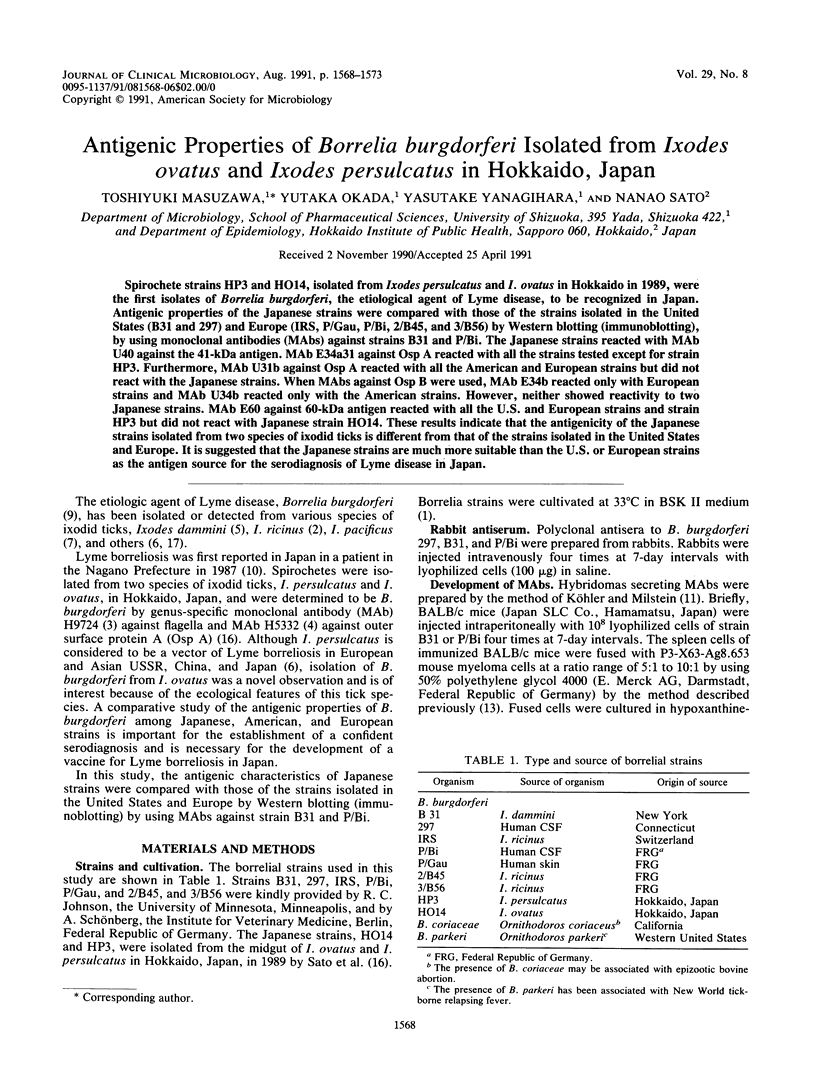
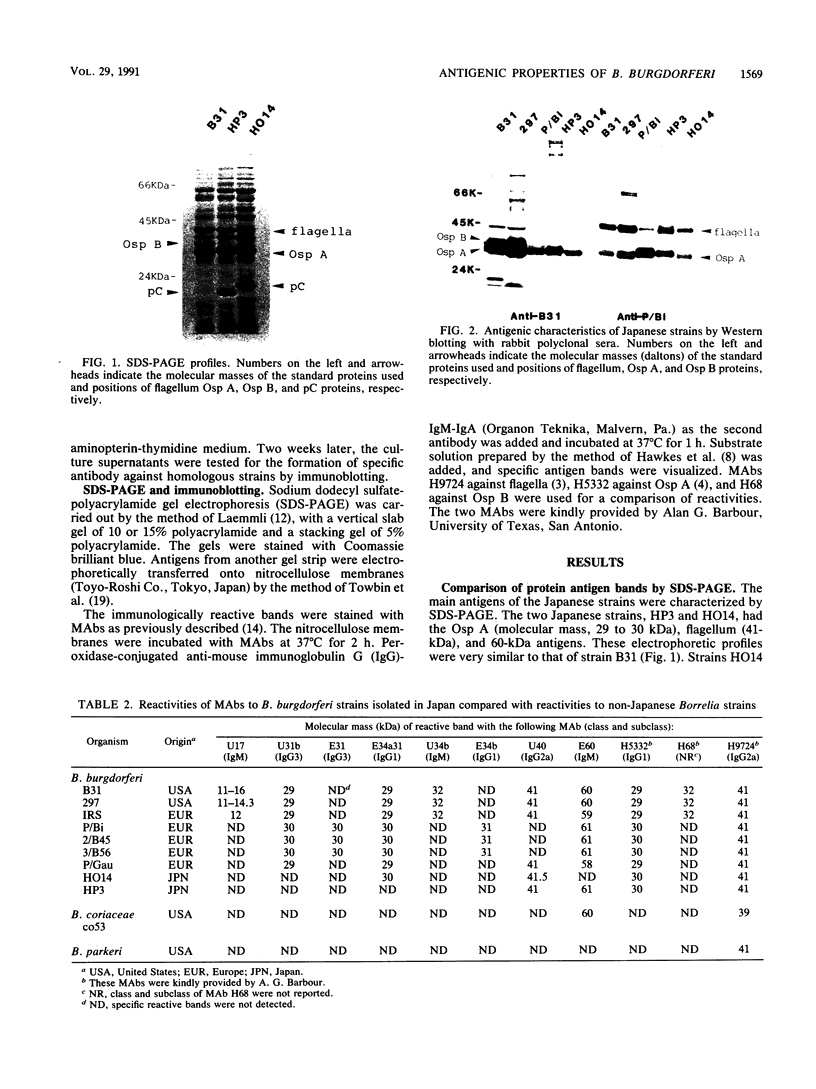
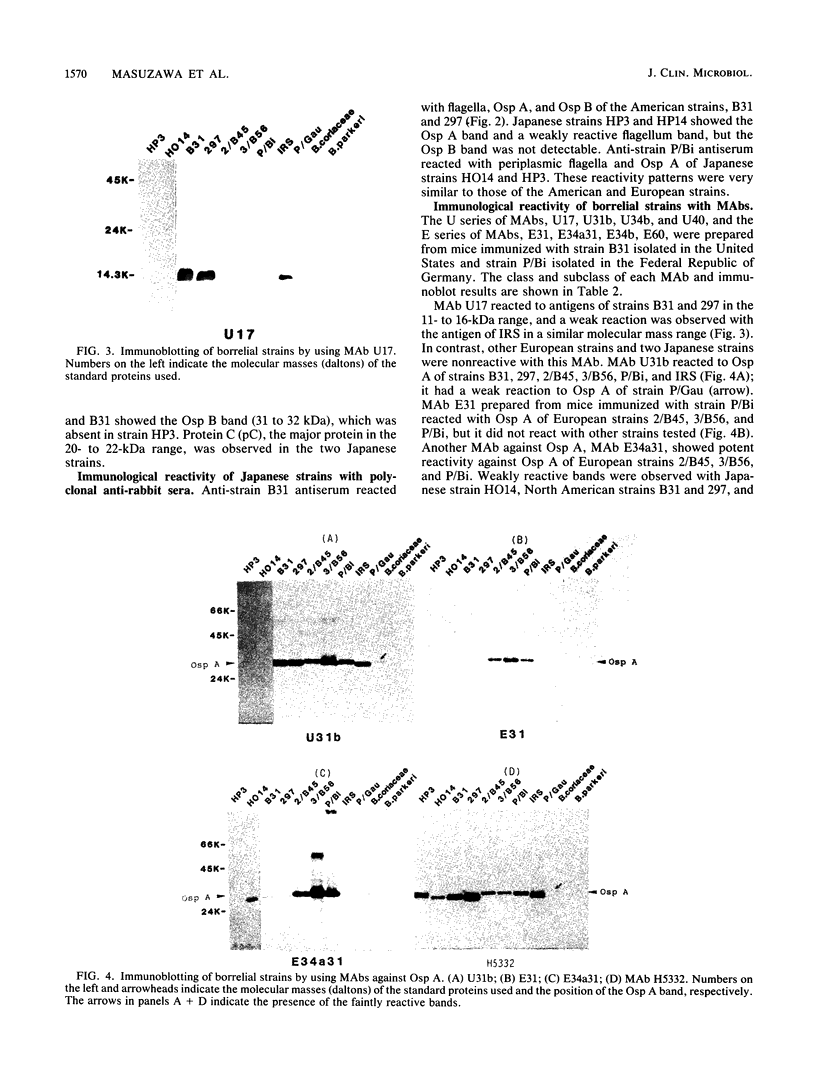
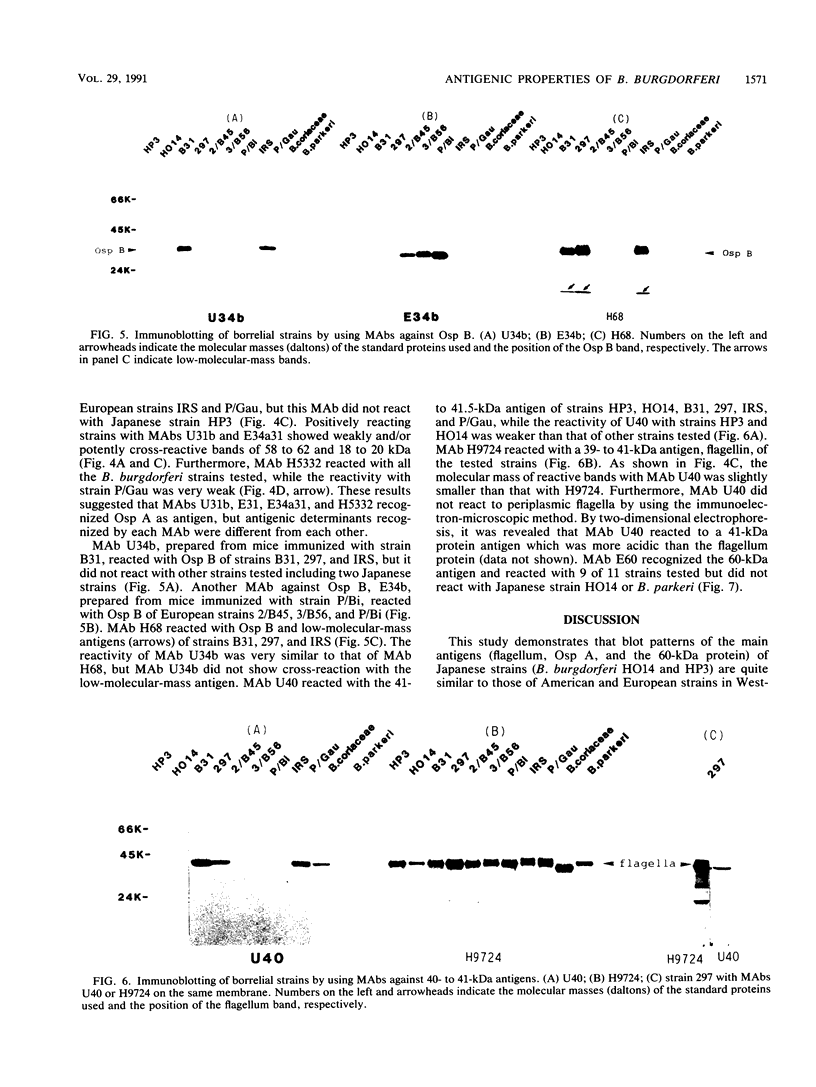
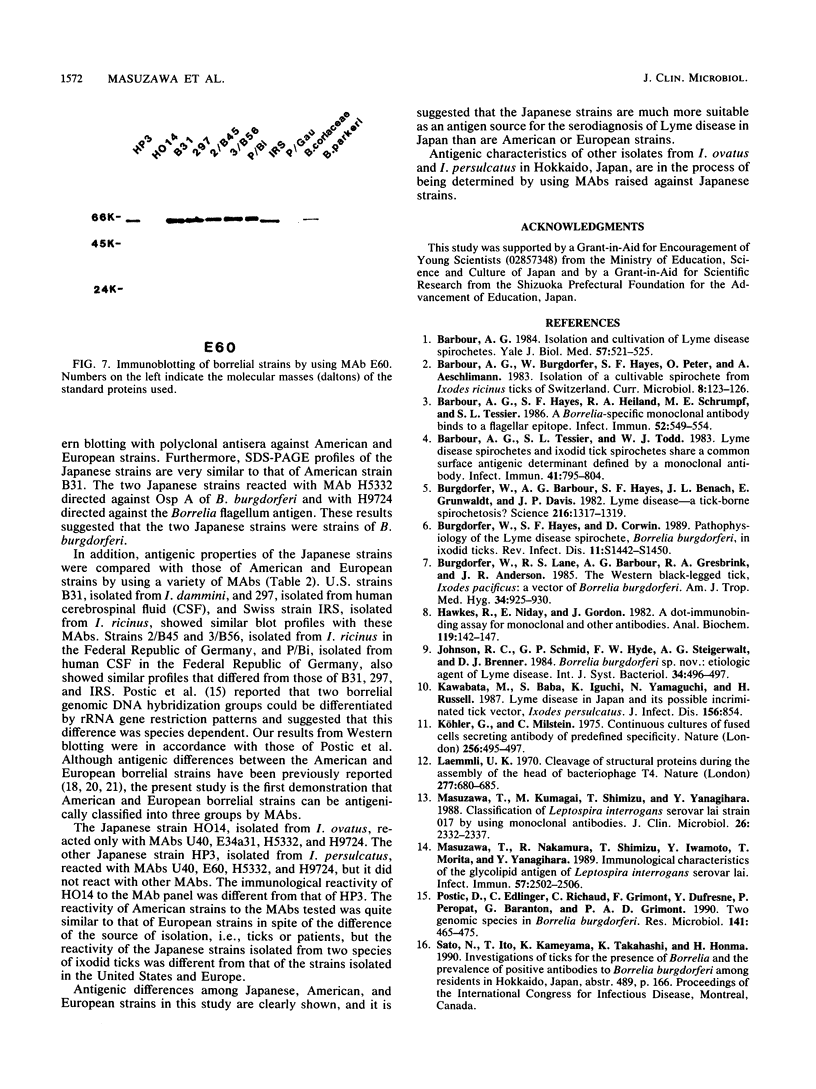
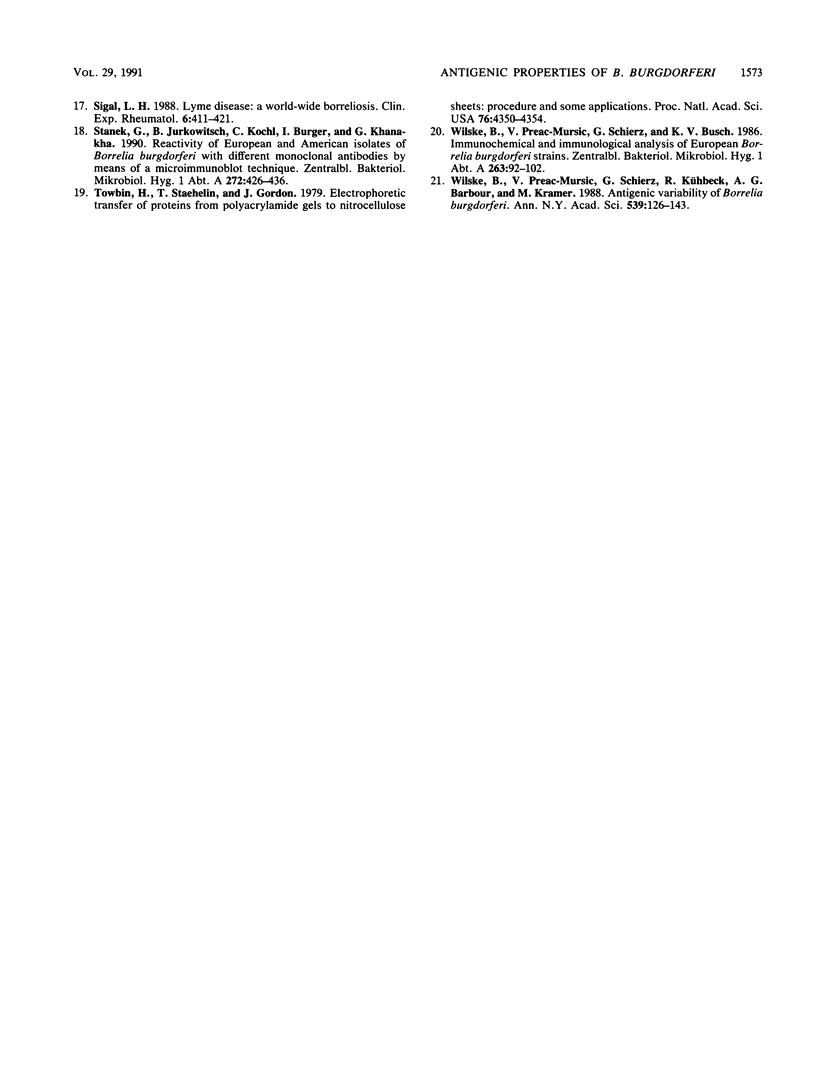
Images in this article
Selected References
These references are in PubMed. This may not be the complete list of references from this article.
- Barbour A. G., Hayes S. F., Heiland R. A., Schrumpf M. E., Tessier S. L. A Borrelia-specific monoclonal antibody binds to a flagellar epitope. Infect Immun. 1986 May;52(2):549–554. doi: 10.1128/iai.52.2.549-554.1986. [DOI] [PMC free article] [PubMed] [Google Scholar]
- Barbour A. G. Isolation and cultivation of Lyme disease spirochetes. Yale J Biol Med. 1984 Jul-Aug;57(4):521–525. [PMC free article] [PubMed] [Google Scholar]
- Barbour A. G., Tessier S. L., Todd W. J. Lyme disease spirochetes and ixodid tick spirochetes share a common surface antigenic determinant defined by a monoclonal antibody. Infect Immun. 1983 Aug;41(2):795–804. doi: 10.1128/iai.41.2.795-804.1983. [DOI] [PMC free article] [PubMed] [Google Scholar]
- Burgdorfer W., Barbour A. G., Hayes S. F., Benach J. L., Grunwaldt E., Davis J. P. Lyme disease-a tick-borne spirochetosis? Science. 1982 Jun 18;216(4552):1317–1319. doi: 10.1126/science.7043737. [DOI] [PubMed] [Google Scholar]
- Burgdorfer W., Hayes S. F., Corwin D. Pathophysiology of the Lyme disease spirochete, Borrelia burgdorferi, in ixodid ticks. Rev Infect Dis. 1989 Sep-Oct;11 (Suppl 6):S1442–S1450. doi: 10.1093/clinids/11.supplement_6.s1442. [DOI] [PubMed] [Google Scholar]
- Burgdorfer W., Lane R. S., Barbour A. G., Gresbrink R. A., Anderson J. R. The western black-legged tick, Ixodes pacificus: a vector of Borrelia burgdorferi. Am J Trop Med Hyg. 1985 Sep;34(5):925–930. doi: 10.4269/ajtmh.1985.34.925. [DOI] [PubMed] [Google Scholar]
- Hawkes R., Niday E., Gordon J. A dot-immunobinding assay for monoclonal and other antibodies. Anal Biochem. 1982 Jan 1;119(1):142–147. doi: 10.1016/0003-2697(82)90677-7. [DOI] [PubMed] [Google Scholar]
- Kawabata M., Baba S., Iguchi K., Yamaguti N., Russell H. Lyme disease in Japan and its possible incriminated tick vector, Ixodes persulcatus. J Infect Dis. 1987 Nov;156(5):854–854. doi: 10.1093/infdis/156.5.854. [DOI] [PubMed] [Google Scholar]
- Köhler G., Milstein C. Continuous cultures of fused cells secreting antibody of predefined specificity. Nature. 1975 Aug 7;256(5517):495–497. doi: 10.1038/256495a0. [DOI] [PubMed] [Google Scholar]
- Laemmli U. K. Cleavage of structural proteins during the assembly of the head of bacteriophage T4. Nature. 1970 Aug 15;227(5259):680–685. doi: 10.1038/227680a0. [DOI] [PubMed] [Google Scholar]
- Masuzawa T., Kumagai M., Shimizu T., Yanagihara Y. Classification of Leptospira interrogans serovar lai strain 017 by using monoclonal antibodies. J Clin Microbiol. 1988 Nov;26(11):2332–2337. doi: 10.1128/jcm.26.11.2332-2337.1988. [DOI] [PMC free article] [PubMed] [Google Scholar]
- Masuzawa T., Nakamura R., Shimizu T., Iwamoto Y., Morita T., Yanagihara Y. Immunological characteristics of the glycolipid antigen of Leptospira interrogans serovar lai. Infect Immun. 1989 Aug;57(8):2502–2506. doi: 10.1128/iai.57.8.2502-2506.1989. [DOI] [PMC free article] [PubMed] [Google Scholar]
- Postic D., Edlinger C., Richaud C., Grimont F., Dufresne Y., Perolat P., Baranton G., Grimont P. A. Two genomic species in Borrelia burgdorferi. Res Microbiol. 1990 May;141(4):465–475. doi: 10.1016/0923-2508(90)90072-x. [DOI] [PubMed] [Google Scholar]
- Sigal L. H. Lyme disease: a world-wide borreliosis. Clin Exp Rheumatol. 1988 Oct-Dec;6(4):411–421. [PubMed] [Google Scholar]
- Stanek G., Jurkowitsch B., Köchl C., Burger I., Khanakha G. Reactivity of European and American isolates of Borrelia burgdorferi with different monoclonal antibodies by means of a microimmunoblot technique. Zentralbl Bakteriol. 1990 Apr;272(4):426–436. doi: 10.1016/s0934-8840(11)80043-5. [DOI] [PubMed] [Google Scholar]
- Towbin H., Staehelin T., Gordon J. Electrophoretic transfer of proteins from polyacrylamide gels to nitrocellulose sheets: procedure and some applications. Proc Natl Acad Sci U S A. 1979 Sep;76(9):4350–4354. doi: 10.1073/pnas.76.9.4350. [DOI] [PMC free article] [PubMed] [Google Scholar]
- Wilske B., Preac-Mursic V., Schierz G., Busch K. V. Immunochemical and immunological analysis of European Borrelia burgdorferi strains. Zentralbl Bakteriol Mikrobiol Hyg A. 1986 Dec;263(1-2):92–102. doi: 10.1016/s0176-6724(86)80108-0. [DOI] [PubMed] [Google Scholar]
- Wilske B., Preac-Mursic V., Schierz G., Kühbeck R., Barbour A. G., Kramer M. Antigenic variability of Borrelia burgdorferi. Ann N Y Acad Sci. 1988;539:126–143. doi: 10.1111/j.1749-6632.1988.tb31846.x. [DOI] [PubMed] [Google Scholar]









